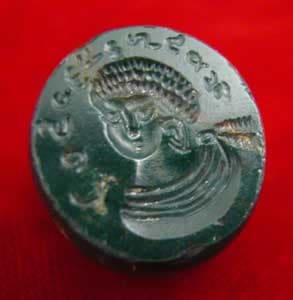Sassanian Green Jasper Seal, 200 CE - 600 CE
Jasper
1.9 x 1.9 x 1.6 cm
3/4 x 3/4 x 5/8 in
3/4 x 3/4 x 5/8 in
FJ.0447
In 244 CE, Ardeshir I founded the Sassanid Dynasty, the last native Persian Kingdom to rule Ancient Iran before the Islamic conquest. The Sassanid era was a golden age of...
In 244 CE, Ardeshir I founded the Sassanid Dynasty, the last native Persian Kingdom to rule Ancient Iran before the Islamic conquest. The Sassanid era was a golden age of Persian culture that witnessed the revival of Zoroastrianism, an ancient mystical religion native to these lands, and a literary Renaissance spurred by the translation of many Old Persian epics recorded in cuneiform into the Middle Persian language of Pahlavi written in an alphabet derived from Aramaic. By introducing heightened international trade and commerce they created a legacy of political and economic diplomacy. They sponsored trade with the Romans (later on the Byzantines), their archenemy, to the west and the Chinese to the east. Excavations in China have unearthed gold and silver Sassanid coins covering a span of many centuries until the demise of the Empire during the reign of Khosrow II. However, the fall of the Empire had already started with a series of wars waged under the rule of Khosrow I, the father of Khosrow II. Challenged by the intensification of the same international commerce that had bore such wealth, struggles for national power and international prestige had escalated to an ungovernable degree. In the face of threats to his royal house, Khosrow II embarked upon military campaigns that would prove unsuccessful. By the close of his reign, the once mighty Sassanid Empire came to an end, paving the way for the rise of Islam in the Middle East.
The delicate rendering of this portrait, perhaps that of a queen or noblewoman, shows a distinct classical influence. Though the Sassanid Dynasty was a formidable rival to Rome, the two empires drew upon the common artistic heritage of Hellenism: very possibly this gem was carved by a Lapidary sensitive to Roman tastes. The inscription shows the lady was a follower of Zoroasterianism: it translates “Beloved of Ohruzd”, the god of light and good. As we gaze upon her image today, we feel somehow the power of her charms reaching out across the centuries.
The delicate rendering of this portrait, perhaps that of a queen or noblewoman, shows a distinct classical influence. Though the Sassanid Dynasty was a formidable rival to Rome, the two empires drew upon the common artistic heritage of Hellenism: very possibly this gem was carved by a Lapidary sensitive to Roman tastes. The inscription shows the lady was a follower of Zoroasterianism: it translates “Beloved of Ohruzd”, the god of light and good. As we gaze upon her image today, we feel somehow the power of her charms reaching out across the centuries.
